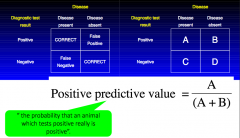![]()
![]()
![]()
Use LEFT and RIGHT arrow keys to navigate between flashcards;
Use UP and DOWN arrow keys to flip the card;
H to show hint;
A reads text to speech;
10 Cards in this Set
- Front
- Back
|
Positive Predictive Value |

likely to be higher for an animal already for an animal already showing clinical signs than in one not showing signs
|
|
|
False Negative |
true positive animals that are undetected (positive animals that erroneously test negative)
|
|
|
False Positive |
true negative animals that are undetected (negative animals that erroneously test positive)
|
|
|
Sensitivity |
proportion of true positives detected (proportion of true positives that are undetected = false negative) |
|
|
Specificity |
proportion of true negatives detected (proportion of true negatives undetected = false positive) |
|
|
Determining Specificity and Sensitivity |

|
|
|
Spectrum Bias |
-using a test in a patient drawn from a population other than the target population (specified by manufacturer) -can alter specificity and sensitivity |
|
|
Calculating Prevalence |

|
|
|
Calculating True Prevalence |

|
|
|
Screening |
-Objective: identify unrecognized cases--positive predictive value matters -increasing sensitivity will increase # of cases found, may decrease specificity and increase # of false positives |

